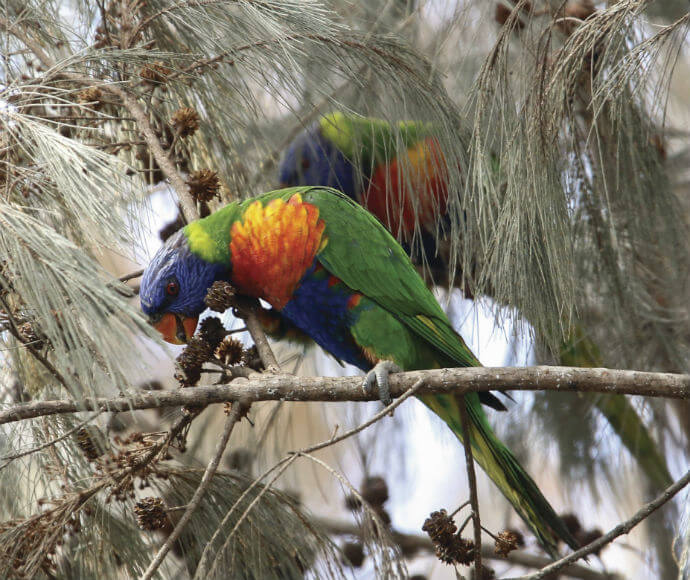The only feeding method we recommend is to plant a variety of flowering native shrubs, such as grevilleas, callistemon (bottlebrushes) and banksias around your garden. These plants not only look good; they also provide safe, healthy food for blossom-feeding birds such as lorikeets and honeyeaters.
Lorikeet feeding habits
Lorikeets are brightly coloured parrots of the family Psittacidae and sub-family Loriinae (lories and lorikeets). Six species are found in Australia.
The tip of a lorikeet's tongue holds a brush-like appendage, enabling the bird to feed on pollen, nectar and fruits. Because lorikeets are mainly seen feeding on blossoms, it was long thought that nectar was their staple diet. However, studies have now shown that pollen is probably their major food. They also eat insects and insect larvae, together with other invertebrates found in foliage and blossom.
Lorikeets travel in small, swift flocks which attract attention with their piercing calls. The birds locate blossoms by sight and by the calls of other birds already feeding. When food is abundant, large numbers gather in the blossoms and foliage, clamouring noisily.
Lorikeets have a very simple digestive system. Proteins and fats are obtained from pollen and insects, and carbohydrates come from the sugars found in nectar. They spend a large amount of time foraging for food, which indicates that carbohydrates are extremely important to them. Their diet is high in energy and low in protein.

Rainbow lorikeet (Trichoglossus haematodus) feeding on allocasuarina seeds.
Feeding lorikeets can cause disease and death
Necrotising enteritis
A bacteria called clostridia is the organism responsible for the disease necrotising enteritis in lorikeets. Symptoms include diarrhoea, vomiting, lethargy and regurgitation.
Necrotising enteritis is associated with poor hygiene and an inadequate diet. The disease is not normally associated with lorikeets living a natural way of life. Scientists directly relate lorikeets' deaths to inadequate artificial diets and to the unsanitary conditions of trays and other feed containers.
Psittacine beak and feather disease
Another disease is also having a serious impact on lorikeets. Called psittacine beak and feather disease (PBFD) or psittacine circovirus disease, it is considered the most important viral disease affecting cockatoos, parrots, lories, lorikeets and macaws around the world.
The disease affects the immune system of the birds. The keratin in the birds' bodies breaks down, causing deformed beaks and feathers, and feather loss. The disease is usually fatal, but infected birds may not display symptoms for many months or even years.
Infected birds can drop faeces, which contain the potentially infectious circovirus particles, into the environment to infect other birds. Unfortunately, there is a great potential for the virus to spread at places like feed stations. Clustering in large numbers, many birds may come into contact with contaminated perches and food dishes.
For more information, see the Australian Government's Psittacine beak and feather disease webpage.
Preventing lorikeet deaths
The best way to prevent lorikeet deaths is to stop feeding the birds altogether. The only feeding method we recommend is to plant a variety of flowering native shrubs, such as grevilleas, callistemon (bottlebrushes) and banksias around your garden.
Protection of native animals
All native birds, reptiles, amphibians and mammals, but not including dingoes, are protected in New South Wales by the Biodiversity Conservation Act 2016.